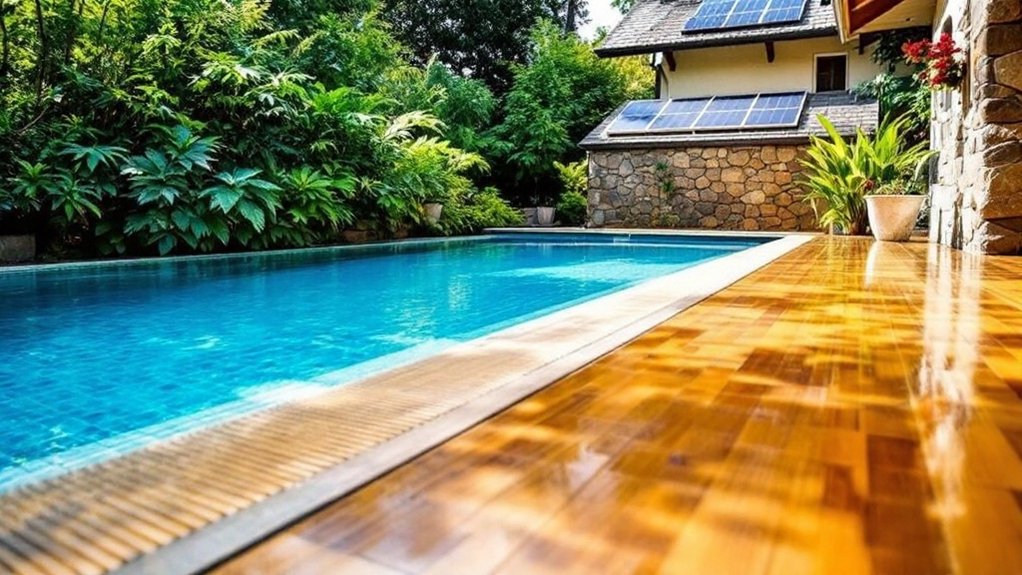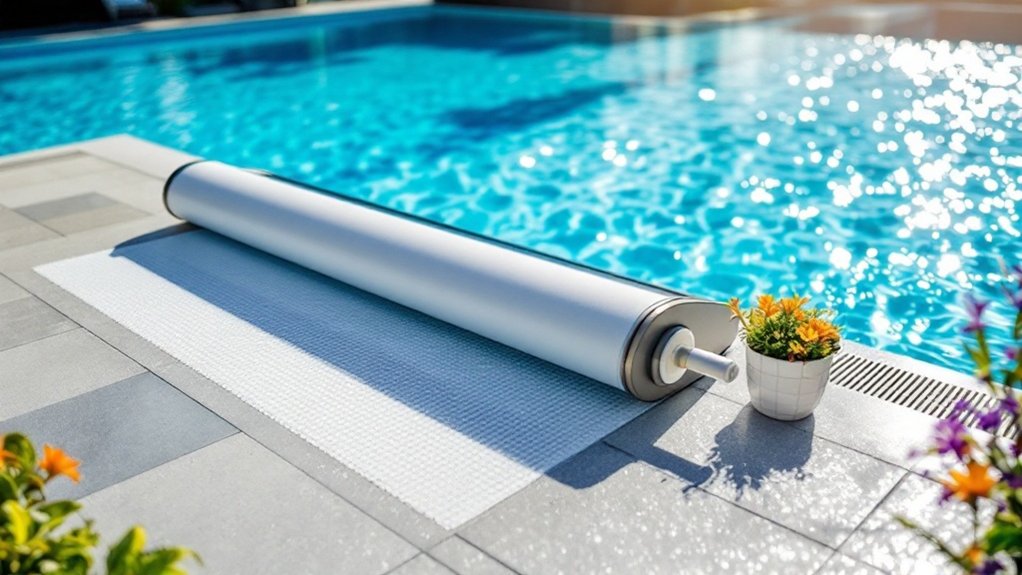The construction of swimming pools has evolved, with an increasing emphasis on sustainability. Homeowners are now exploring materials that not only guarantee durability but also support environmental goals. From recycled concrete to eco-friendly liners, the options are diverse. Each material offers unique benefits that contribute to energy efficiency and reduced waste. As the demand for greener alternatives grows, it raises the question of which materials truly stand out in this transformative landscape.
Recycled Concrete and Glass Aggregate
Recycled concrete and glass aggregate has emerged as a valuable resource in the construction of sustainable swimming pools. Utilizing these materials not only reduces the demand for new resources but also minimizes waste in landfills. The incorporation of crushed concrete and glass into aggregate mixes enhances the structural integrity of pool foundations while providing a unique aesthetic appeal. Additionally, these recycled materials can improve thermal efficiency, contributing to energy savings over time. As the construction industry increasingly prioritizes sustainability, the use of recycled aggregates aligns with environmental goals by lowering carbon footprints and promoting circular economy principles. This innovative approach highlights the potential for repurposing materials, making swimming pool construction more environmentally friendly and resource-efficient.
Sustainable Pool Liners
Sustainable pool liners are increasingly made from eco-friendly materials that reduce environmental impact while maintaining aesthetic appeal. Their durability and longevity contribute to a more sustainable pool construction, minimizing the need for frequent replacements. As awareness of environmental issues grows, the demand for these innovative liners continues to rise.
Eco-Friendly Materials
While traditional pool liners often contribute to environmental degradation, eco-friendly alternatives are gaining traction in the construction of swimming pools. These sustainable pool liners are typically made from recycled materials, such as polyethylene and vinyl, which minimize waste and reduce the demand for new resources. Additionally, some options use natural substances like organic cotton or biodegradable materials, ensuring a lower environmental impact. These eco-friendly liners not only help in conserving resources but also provide safety by being free from harmful chemicals like phthalates and heavy metals. As the push for sustainability grows, more builders and homeowners are recognizing the importance of selecting materials that align with eco-conscious values, ultimately promoting a healthier environment for future generations.
Durability and Longevity
Although many pool owners prioritize aesthetics and cost, the durability and longevity of sustainable pool liners are equally critical factors in their construction. Sustainable pool liners, typically made from materials like recycled vinyl or natural fibers, are designed to withstand harsh environmental conditions. These liners resist UV rays, chemicals, and temperature fluctuations, ensuring they maintain their integrity over time. With proper maintenance, sustainable liners can last considerably longer than traditional options, reducing the need for frequent replacements. This longevity not only benefits the environment by minimizing waste but also provides cost savings for homeowners in the long run. Ultimately, investing in durable, sustainable pool liners enhances both the pool’s functionality and its ecological footprint.
Eco-Friendly Pool Finishes
Eco-friendly pool finishes are gaining popularity as homeowners seek ways to reduce their environmental impact without compromising aesthetics or functionality. These finishes often include natural materials such as recycled glass, which provides a stunning visual effect while minimizing waste. Moreover, options like natural stone and sustainably sourced tiles not only enhance the pool’s beauty but also offer durability and longevity. Eco-friendly plaster alternatives, made from non-toxic materials, provide a safe swimming environment, while being less harmful to aquatic life. In addition, the use of low-VOC sealants guarantees that harmful emissions are minimized. Overall, eco-friendly pool finishes represent a harmonious blend of sustainability and design, appealing to environmentally conscious homeowners who value responsible choices in their outdoor spaces.
Energy-Efficient Heating Systems
Energy-efficient heating systems play an essential role in sustainable swimming pool construction. Solar heating options and the efficiency of heat pumps are two prominent solutions that considerably reduce energy consumption. These technologies not only lower operational costs but also contribute to a more environmentally friendly pool experience. Additionally, gas pool heaters provide reliable warmth and can be an effective solution when combined with renewable energy sources.
Solar Heating Options
A growing number of pool owners are turning to solar heating options to enhance energy efficiency in their swimming pools. These systems utilize solar panels installed on rooftops or adjacent surfaces to capture sunlight, converting it into thermal energy. The heated water is then circulated through the pool, maintaining ideal temperatures without relying heavily on traditional energy sources. Solar heating systems are not only eco-friendly but also reduce long-term operating costs, offering significant savings on utility bills. Additionally, many local governments provide incentives for solar installation, further encouraging adoption. With advancements in technology, modern solar heaters are more efficient and durable, making them an increasingly viable option for sustainable pool heating solutions.
Heat Pump Efficiency
Heat pumps represent another innovative approach to achieving energy-efficient heating for swimming pools. These systems operate by transferring heat from the air or ground to the pool water, using a refrigeration cycle that requires less energy than conventional heating methods. Their efficiency is measured by the coefficient of performance (COP), which indicates the ratio of heat output to energy input. Typically, heat pumps can achieve a COP of 4 or more, meaning they can produce four units of heat for every unit of electricity consumed. This efficiency not only reduces energy costs but also minimizes the carbon footprint associated with pool heating. As a result, heat pumps are increasingly favored for their sustainability and effectiveness in maintaining comfortable swimming temperatures year-round.
Solar Pool Covers and Heating
Harnessing the sun’s energy, solar pool covers provide an effective solution for maintaining water temperature and reducing heat loss. These covers, typically made from durable UV-resistant materials, trap heat generated by sunlight while minimizing evaporation. By covering the pool when not in use, they can raise water temperatures by several degrees, extending the swimming season without additional heating costs. In addition, solar pool covers contribute to water conservation by greatly reducing evaporation rates, which can save thousands of gallons annually. Their lightweight design allows for easy handling and storage, making them a practical choice for pool owners. Ultimately, solar pool covers represent a sustainable investment, combining energy efficiency with environmental benefits, thereby promoting a greener approach to pool maintenance.
Natural Stone and Wood Decking
Natural stone and wood decking offer aesthetically pleasing and eco-friendly options for swimming pool construction. Natural stone, such as slate, granite, or limestone, provides durability and a unique appearance, blending seamlessly with the surrounding environment. Its long lifespan and minimal maintenance requirements make it a sustainable choice. Additionally, stone’s natural thermal properties help regulate temperature, enhancing comfort for swimmers.
Wood decking, particularly when sourced from sustainably managed forests, adds warmth and a natural feel to pool areas. Options like teak and redwood are resistant to decay and can withstand varying weather conditions. Both materials contribute to a beautiful and functional outdoor space while promoting environmental stewardship. Their use reinforces a commitment to sustainability without compromising on style or quality.
Water Conservation Technologies
While traditional swimming pools can consume significant amounts of water, innovative water conservation technologies are emerging to address this challenge effectively. One notable advancement is the use of automatic pool covers, which minimize evaporation and reduce water loss when the pool is not in use. Additionally, rainwater harvesting systems can collect and utilize natural precipitation for pool filling and maintenance, further conserving municipal water resources. Filtration systems that recycle water enhance efficiency, allowing for cleaner water with less frequent replacements. Furthermore, smart irrigation systems manage landscaping around pools, ensuring minimal water waste. These technologies not only promote sustainable practices but also help pool owners save on water costs, making them essential components of environmentally responsible swimming pool construction.
Frequently Asked Questions
How Do Sustainable Materials Impact Pool Maintenance Costs?
Sustainable materials positively influence pool maintenance costs by enhancing durability and reducing the need for frequent repairs. Their resistance to environmental wear leads to lower expenditures over time, ultimately benefiting both homeowners and the ecosystem.
Are Sustainable Pools More Expensive to Build Initially?
The initial construction costs of sustainable pools can be higher due to premium materials and technologies. However, long-term savings on maintenance and energy efficiency often offset these initial investments, making them economically viable over time.
What Is the Lifespan of Eco-Friendly Pool Materials?
The lifespan of eco-friendly pool materials varies greatly, typically ranging from 15 to 50 years. Factors such as material quality, maintenance practices, and environmental conditions play vital roles in determining durability and longevity.
Can I Retrofit My Existing Pool With Sustainable Materials?
Retrofitting an existing pool with sustainable materials is possible and often beneficial. Homeowners can utilize eco-friendly options to enhance energy efficiency and reduce maintenance, ultimately contributing to a more environmentally friendly swimming experience.
How Do I Ensure My Pool Construction Is Environmentally Friendly?
To guarantee environmentally friendly pool construction, one should prioritize sustainable materials, efficient design, energy-saving systems, and responsible water management practices, while also considering the local ecosystem and potential impacts on surrounding wildlife and habitats.
Conclusion
Incorporating sustainable materials in swimming pool construction not only enhances aesthetic appeal but also greatly reduces environmental impact. From recycled concrete and glass aggregates to eco-friendly liners and finishes, these choices align with eco-conscious values while promoting energy efficiency. By utilizing natural stone, wood decking, and water conservation technologies, homeowners can create beautiful, functional pools that contribute to a healthier planet. Embracing these sustainable options is essential for those looking to make mindful contributions to environmental preservation.




